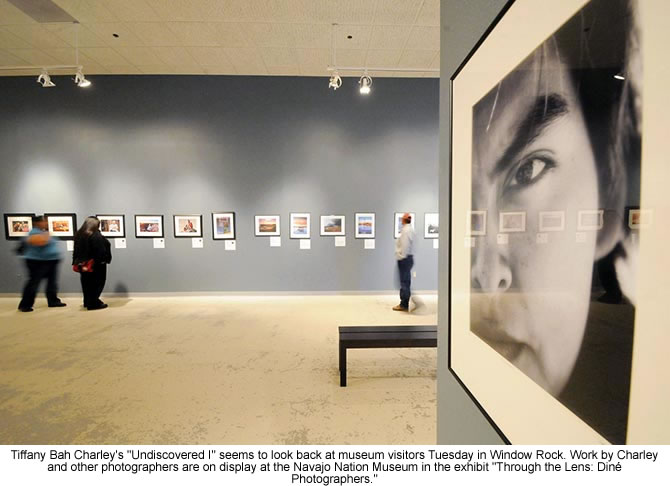 |
Canku Ota
|
 |
|
(Many Paths)
|
||
|
An Online Newsletter
Celebrating Native America
|
||
|
November 1, 2009 - Volume
7 Number 11
|
||
|
|
||
|
Expression The Diné
Way
|
||
|
by Cindy Yurth - Tséyi'
Bureau, The Navajo Times
|
||
|
credits: photos by Donovan
Quintero -Special to the Navajo Times
|
|
Diné photographers take their place on the other side of the lens
WINDOW ROCK, AZ - For nearly two centuries, Native Americans have been the subjects of photographs. But when a prominent Western museum called Navajo Nation Museum exhibit curator Clarenda Begay and asked for the names of some Navajo photographers, "the only one I could think of was Leroy Dejolie," she said. That got Begay thinking. If even Navajos don't know their own photographers, what hope do they have of getting discovered by the rest of the world? Begay approached her boss, museum director Manuelito Wheeler, about hosting an exhibit of Navajo photographers. Wheeler was enthusiastic and he and Begay came up with the idea of a juried exhibition - one in which awards are given - to let the cream rise to the top.
Diné photographers from the Four Corners and beyond, amateurs and professionals, young and elderly - 43 in all - submitted works. The variety of expression is stunning. Some concentrated on documenting a vanishing way of life. Others wanted to show the tribe's contemporary face. Beautiful landscapes are to be expected in these parts, but there are also disturbing graphic images like Tucson resident William Wilson's "Autoimmune Response" series. "I appreciate what he's doing, but I don't like to look at them too long," noted Begay, gazing at a large image of a blood-spattered, gas-mask-wearing Wilson in front of a flooded field. Melynda Mitchell used her camera to explore subconscious racial responses, posing two young men - one white and one Native - in an identical trio of T-shirts. One T-shirt says, "Engine," which looks like a wordplay on "Injun" on the Native model. Another says "Mascot," which, worn by the Native, conjures up images of the Indian mascots used by some sports teams. The third shirt is printed with the word "Giver," which makes the mind flash "Indian giver" on the body of the Native man. On the Anglo model, the shirts "don't make sense," Mitchell notes in her explanation of the work. Some of the amateur works reflect the photographers' day jobs: archeologist Curtis Yazzie captured an Anasazi ruin bathed in yellow sunlight; soil technician Wilson Halwood Jr. had his camera handy when a trio of beautiful horses stuck their heads out of the brush to see what he was up to. Most of the 90 images on display are unposed and naturally lit, but some artists used a few Photoshop tricks. Jinnibah Manuelito turned the Statue of Liberty into a Diné woman and planted the Washington Monument in Crownpoint for a startling juxtaposition of two iconic Americas. Priscilla Tacheney gives her "Embracing the Way of the Medicine Man" a magical quality by colorizing only the subject's bright red robe and the turquoise jewelry. Many of the works on display are for sale - look for the letters "MS" on the plaques and inquire at the museum's gift shop. If you can't afford a photograph, the museum is also offering a screensaver CD featuring all the photographs and pictures of the artists along with their contact information. "Hopefully it will get into the right hands," Begay said mischievously. Meanwhile, this is an exhibit that deserves some time and contemplation. While it has received good reviews from patrons, Begay most enjoys seeing the photographers come by with their families. "They're so proud of what they've done," she said. "It's really fun to watch them." As photographer Lorita Bigman observes in the comments that accompany her work, "Only a Diné could capture the true essence of Navajo life." Admission is free. Hours are Monday, 8 a.m. to 5 p.m.; Tuesday through Friday, 8 a.m. to 7 p.m.; Saturday 9 a.m. to 5 p.m.; Sunday closed. On Nov. 1, after Daylight Savings Time ends, the museum will close at 6 p.m. Tuesday through Friday. Information: Clarenda Begay, 928-810-8540, or clarenda@navajonationmuseum.org. |
|
|
||
|
|
||
| Canku Ota is a free Newsletter celebrating Native America, its traditions and accomplishments . We do not provide subscriber or visitor names to anyone. Some articles presented in Canku Ota may contain copyright material. We have received appropriate permissions for republishing any articles. Material appearing here is distributed without profit or monetary gain to those who have expressed an interest. This is in accordance with Title 17 U.S.C. Section 107. | ||
|
Canku Ota is a copyright ©
2000, 2001, 2002, 2003, 2004, 2005, 2006, 2007, 2008, 2009 of Vicki
Barry and Paul Barry.
|
||
 |
 |
|
|
The "Canku
Ota - A Newsletter Celebrating Native America" web site and
its design is the
|
||
|
Copyright ©
1999, 2000, 2001, 2002, 2003, 2004, 2005,
2006, 2007, 2008, 2009 of Paul
C. Barry.
|
||
|
All Rights Reserved.
|
||

 The
result, "Through the Lens: Diné Photographers,"
on display through next March, exceeded their expectations.
The
result, "Through the Lens: Diné Photographers,"
on display through next March, exceeded their expectations.